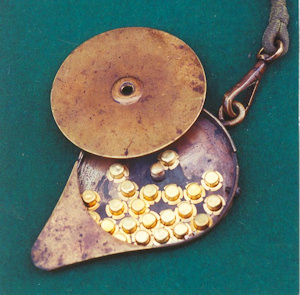Introduction > Rifle > Equipment > Ammunition > Shooting > Cleaning > Bedding
Equipment
The choice of appropriate equipment to accompany your Enfield can be split between the essential and the optional.
Essentials are a bullet mould, a “Combination Tool”, and a means of measuring out powder charges accurately and safely. The usual moulds in use today are those designed for the American Burton style, cannelured, hollow based bullet which is lubricated with an appropriate grease (of which more later) and loaded straight on top of the powder charge without any wadding or paper wrapping. This is not the original bullet for the Enfield which was a paper patched smooth cylindro-conoidal projectile designed by Metford and Pritchett and subsequently modified by Boxer with an expanding plug in the base. These are far harder to make and commercially made modern moulds for them are not obtainable. The Burton bullet was designed for the American Springfield rifles which are substantially the same as the Enfields in the bore and rifling. Given the large United States market for muzzle loading shooters it is hardly surprising that the modern commercially made moulds should originate there. There are two basic mould models which vary only in the depth of the base cavity. A single mould with alternative base plugs will suffice for both Long and Short Rifles. The deep cavity gives a lighter bullet with characteristics which suit the rifling spiral of 78 inches. The shallow cavity and heavier weight of the alternative are best suited to the 48 inch spiral of the Naval and later Army Short Rifles. The ballistic reasoning behind this choice must be taken for granted. The original modern mould best known to all is the Lyman 575213 but similar ones are also made by Ohaus and others. The finished and greased bullets need a clean container which will prevent dust or grit contaminating the grease.
A Combination Tool is an essential requirement. Original examples can still be found and new working copies are made and can be bought from specialist dealers. These gadgets incorporate into one tool a nipple key, a pricker, an oil bottle, a screwdriver, a double pronged worm for cleaning, and tools for extracting jammed bullets. Those items intended to be passed down the bore will fit on to the end of the standard modern cleaning rod which, by great good fortune, has retained the original Enfield screw thread in use since the 1840’s or perhaps even earlier. They also include fixed jaws intended to allow removal of the mainspring of the lock when stripping it. This last fitting was limited on original tools to those for the use of Sergeants.
Combination tools – sergeant’s and private’s models
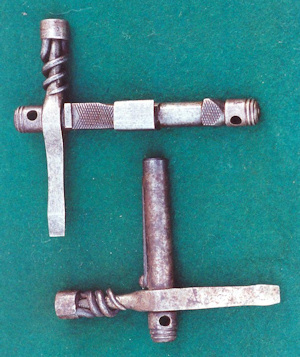
Sergeant’s combination tool dismantled showing, large and small blade screwdriver, pointed piercer and screw for drawing jammed bullets and double worm for cleaning. The body incorporates a nipple key and pricker with a main spring clamp on the side, and internally is an oil bottle.
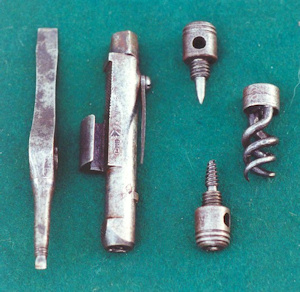
Measuring the powder requires either a good quality flask with a measuring top or a set of powder scales and a number of small containers with lids to hold the individual charges.
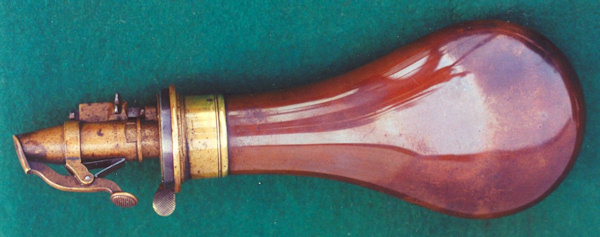
The full list of other equipment must be left to the pocket and taste of the shooter and will in most cases be applicable to other styles or classes of shooting. But, for those who are seeking inspiration, here is a list of the items which the writer considers to be fairly normal. For the rifle itself — a sling, a flash shield to fit under the nipple, sight blacking (paint on, spray or carbide lamp), spare nipple and, should the butt plate be found to slip on contact with the shoulder, some self adhesive bandage of the Elastoplast type to provide a non slip surface. To be applied to the person of the shooter — a decent shooting jacket, a shooting glove for the forward hand, ear and eye protection, a hat, and a shooting mat to lie on. For use during the shoot — a telescope, a target record book with the appropriate target diagram, a pen or waterproof pencil, a small table to hold the loading equipment, with a notch to rest the barrel of the rifle in. For loading — a standard modern cleaning rod with a tip made in the form of the head of a ramrod; this can also be used as the cleaning rod although it is better to have two (the original fitted rod should be left in place and not moved), a plastic funnel to be inserted in the muzzle when pouring in the powder ( the long loading tube gives no advantage and takes up valuable space), and something in which to keep the percussion caps which should be left on the firing point as the act of capping can only be made when in the firing position. There is a useful accessory for this which keeps the caps in a brass container and delivers them one at a time straight onto the nipple.
Enfield P’61 short rifle showing the flash shield, known in the 1860s as a “Flash Pan”
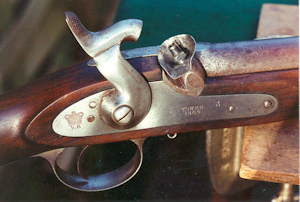
Capping device
